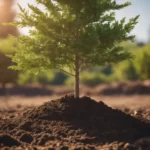Transplanting lavender is a key step in ensuring the longevity and vitality of these fragrant and visually appealing plants. Known for their soothing scent and beautiful purple blooms, lavender plants are a favorite in gardens worldwide. This guide focuses on the critical aspects of timing, techniques, and considerations for successfully transplanting lavender, ensuring it thrives in its new location.
Lavender and Its Growth Habits
Lavender, belonging to the genus Lavandula, is a hardy perennial known for its aromatic flowers and silvery-green foliage. It’s essential to understand lavender’s growth habits for successful transplantation. Lavender plants develop extensive root systems and prefer well-drained soil. They typically bloom in late spring to early summer, with some varieties offering a second bloom in the fall. The plant’s growth and bloom cycles are important considerations when planning a transplant, as moving the plant at the wrong time can impact its health and flowering.
Timing for Transplanting Lavender
The best time to transplant lavender is in the spring or early fall. These seasons provide mild temperatures and favorable conditions for root establishment. In spring, aim to transplant after the last frost when the soil is warm and workable. This gives the plant enough time to establish before the heat of summer. Fall transplanting should be done well before the first frost, allowing roots to establish before winter dormancy. For mature lavender plants, it’s often better to transplant in the fall, as this minimizes stress during the active growing season. Young plants, however, can be more adaptable and may be transplanted in either season. The plant’s age, health, and the specific climate of your area are key factors in determining the optimal transplanting time.
Pre-Transplant Preparation
Preparing for the transplant of lavender involves several important steps. First, choose a location that receives full sun, as lavender thrives in bright light. The soil should be well-draining, as lavender does not tolerate wet feet. Consider amending the soil with sand or gravel to improve drainage if necessary. Test the soil pH, aiming for a range between 6.5 and 7.5, which is ideal for lavender. If you’re transplanting an existing lavender plant, prepare it by pruning any excessively long roots or overgrown foliage. This helps reduce transplant shock and encourages the plant to focus on reestablishing its root system in the new location.
The Transplanting Process
Transplanting lavender should be done with care to minimize stress to the plant. Begin by digging a hole that is as deep as the root ball and twice as wide. This provides ample space for the roots to spread out. Carefully remove the lavender from its current location, trying to keep the root ball intact. Place the plant in the new hole, ensuring it is at the same depth it was growing previously. Backfill the hole with soil, gently firming it around the roots to eliminate air pockets. Water the plant thoroughly after transplanting to settle the soil and provide hydration. However, be cautious not to overwater, as lavender prefers drier conditions.
Post-Transplant Care
After transplanting lavender, it’s important to provide proper care to support its recovery and growth. Water the plant deeply but infrequently, allowing the soil to dry out between waterings. This encourages deep root growth. Avoid heavy fertilization, as lavender does well in less fertile soil. A light application of compost or organic matter can be beneficial but avoid high-nitrogen fertilizers. Keep an eye on the plant for signs of transplant shock, which may include wilting, leaf drop, or a lack of new growth. If any of these symptoms occur, assess your watering and care routine to ensure it aligns with the needs of the plant. With the right care, your transplanted lavender should soon start to establish itself and show signs of new growth.
Ongoing Maintenance and Care
Maintaining your lavender plant post-transplantation is crucial for its health and flowering. Regular pruning is essential; trim the lavender after flowering to shape the plant and encourage bushy growth. This also helps prevent the center from becoming woody and sparse. Lavender typically requires little watering once established, especially in climates with regular rainfall. Overwatering can lead to root rot, so ensure the soil has good drainage. Monitoring for pests, such as aphids and whiteflies, and diseases like root rot and fungal infections, is also important. Use appropriate organic or chemical treatments as needed, following all safety guidelines.
Strategies for Winterizing Lavender
In colder regions, winterizing lavender is vital to protect it from harsh conditions. Although lavender is generally hardy, it can suffer in freezing temperatures and wet soils. Before the onset of winter, add a layer of mulch around the base of the plant to insulate the roots, being careful not to cover the plant’s crown. In areas with severe winter conditions, consider covering the lavender with burlap or a frost cloth to provide additional protection. However, ensure the cover is not too heavy or moisture-retaining, as this could do more harm than good.
Conclusion
Transplanting lavender can rejuvenate an old plant, help manage overgrowth, and enhance your garden’s design. By choosing the right time for transplanting, preparing adequately, and providing ongoing care, your lavender will continue to thrive and bring beauty and fragrance to your garden. Remember, each plant is unique, and observing its response to transplanting can provide valuable insights for future gardening endeavors. With patience and attention, your lavender will flourish, offering its delightful blooms year after year.




